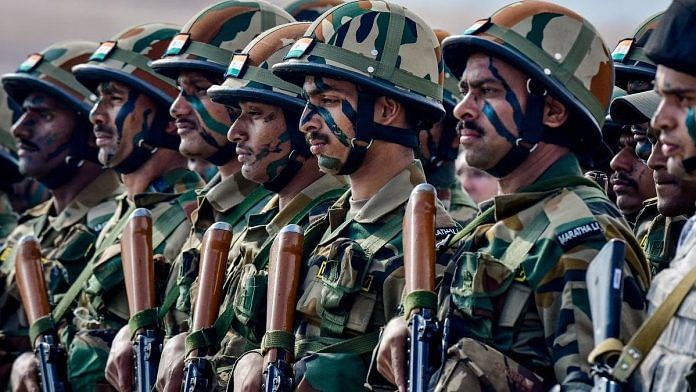India faces unique challenges due to its inimical nuclear-armed neighbours, Pakistan on the western border and China on the northern border. India has fought wars with both countries, and the threat of a collusive partnership between them remains a concern. However, it is crucial to recognise the vast difference between preparing for a two-front threat and actually fighting a two-front war. These terms are often used interchangeably due to a lack of understanding.
Preparing for a two-front threat involves structuring forces to counter the potential threat on each front. In India’s context, this includes having more mechanised formations for the western front and more infantry for the northern front. Even the nature and type of artillery for each front would be different, as would be the composition of combat support and administrative elements. The doctrines for operations on these fronts – rapid deep thrusts by mechanised forces in the plains and deserts in the west, as opposed to dogged time-consuming infantry assaults in mountainous terrain to the north – would also differ significantly, as would the training requirements.
Therefore, preparing for a two-front threat is not the same as fighting a two-front war. We must avoid falling into the trap of seriously considering simultaneously fighting on two fronts out of false bravado or gung-ho attitude.
Also read: Pulwama mosque, Manipur incidents bad for Army’s image. There’s need for course correction
Lines of Communication
For the military in an operational setting and for the country at the strategic level, a two-front scenario boils down to whether one is operating on Interior or Exterior lines of communication. If the lines connecting the base (where the Army draws its strength) and the front (where the fight is) are divergent, the force is operating on Interior lines of communication. Conversely, if the lines joining the base(s) and the front are converging, then the force is operating on Exterior lines of communication. As operations unfold, the components of the force operating on Interior lines spread further apart and dissipate, while those on Exterior lines converge towards a common objective, resulting in a concentration of force – a key principle of war. The Bangladesh Liberation War of 1971 is a classic example of how a force operating on Exterior lines defeated an equally matched force on Interior lines.
This tenet of convergence applies at all levels of the operational and tactical chain. At the operational level, envelopment manoeuvres—whether single envelopment or double envelopment, the classic German pincer movements—were nothing but dynamic operations from the outside to the inside, bringing greater combat power at the point of decision.
This is equally true at the tactical level where simultaneous multi-directional attacks on the given objective are the preferred option. Placing a force to the rear of the enemy by infiltration or through airborne operations once again aims at making the adversary face two directions (fronts) at the same time. ‘Nine out of ten times’ the force operating on Exterior lines will emerge victorious. It is akin to a boxer in the ring fighting two opponents of similar ability. Given enough time, two will prevail over one.
Zooming out, India is like that boxer facing two opponents. As a country, we need to prepare to deal with both threats individually and collusively, leveraging all instruments of national power, namely diplomacy, information, military, and economy (DIME). At the diplomatic level, treaties and alliances will play a major role in conflict prevention and if conflicts arise, in keeping one of the opponents at bay.
Also read: Modi’s visit to Heliopolis shows India is no longer ashamed of its British Army soldiers
History is proof
A clear example of India successfully tackling the two-front threat was when the Indo-Soviet Treaty of Peace, Friendship and Cooperation was signed in August 1971, which effectively kept China out of the contest in the Bangladesh Liberation War. India, while being acutely conscious of the two-front threat, was equally conscious of the fact that a two-front war was not pragmatic. Even with China out of the contention, India did still fight on two fronts – against Pakistan and erstwhile East Pakistan – but it was against the same single opponent having finite resources.
In a similar vein, Germany entered into what is commonly known as the Molotov–Ribbentrop Pact on 23 August 1939 with the Soviet Union – which was essentially a non-aggression pact just before Germany invaded Poland on 1 September 1939. This ensured that Germany would only have to fight a one-front war in Western Europe. Unfortunately, Germany committed the cardinal error of opening a second front when it launched Operation Barbarossa against the Soviet Union in June 1941, without first having subdued the western front in its entirety. This allowed the Allied Forces to launch Operation Overlord, the amphibious landings on the beaches of Normandy, France, thereby opening a second front.
This two-front war scenario was the leading cause of German capitulation. Germany was reduced to fighting on diagrammatically opposite interior lines, while the Allied forces were on exterior lines, including the southern approach through Italy.
History is replete with such examples where fighting on multiple fronts simultaneously has almost always resulted in defeat. There have been a few campaigns and battles though – one out of ten – where forces on Interior lines have prevailed, but the causes for such victories lie elsewhere. These battles are the exceptions that prove the rule. At the level of grand strategy, fighting a full-fledged two-front war is a no-go, whether for India or any other country.
General Manoj Mukund Naravane PVSM AVSM SM VSM ADC is a retired Indian Army General who served as the 28th Chief of the Army Staff. Views are personal.
(Edited by Ratan Priya)



